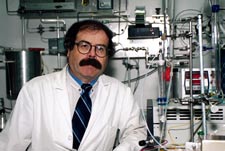
|
|
October 2004 |
Muradov Investigates Environmentally Friendly Production of Hydrogen Dr.
Nazim Muradov of the Hydrogen R&D Division of the Florida Solar
Energy Center® (FSEC®) is working
on a novel approach to solving the energy and environmental problems
associated with producing hydrogen from fossil fuels. He’s
working with other FSEC researchers on the technical and economic
feasibility of large-scale production of hydrogen and carbon by
the catalytic dissociation of natural gas.
This concept offers an environmentally friendly way to produce hydrogen. Most of the industrial hydrogen production today is based on the steam methane reforming process, a source of significant CO2 emissions into the atmosphere (about 10 tons of CO2 per ton of hydrogen produced). Muradov points out, “It’s felt by many energy experts that the huge quantities of CO2 emissions that come from using fossil fuels to produce hydrogen might potentially diminish the environmental appeal of hydrogen as an ecologically clean fuel.” Carbon dioxide sequestration (underground or under the ocean) is being actively discussed in the literature as a possible solution to this environmental problem. However, many experts have expressed concerns regarding the unpredictable and potentially catastrophic ecological consequences of this approach. Muradov’s work is aimed at eliminating the production of CO2 rather than worry about getting rid of it after the hydrogen has been produced. That’s why he has been studying the CO2-free production of hydrogen and carbon via thermal decomposition (or cracking) of methane. Several important technical issues still need to be addressed before the large-scale implementation of this technology would be possible. Muradov pointed out that the most serious problem is how to arrange a continuous and sustainable process for methane decomposition with incessant withdrawal of carbon from the reactor. “The root of the problem lies in the fact that carbon product tends to accumulate on the catalyst surface gradually deactivating it,” he explained, “and as a result, it decreases the yield of hydrogen.” Muradov and other FSEC researchers have come up with an original solution to this problem by turning this apparent technical obstacle to their advantage. They have discovered that at certain operational conditions, carbon itself becomes a catalyst for the process. This eliminates the use of expensive metal-based catalysts and significantly simplifies the process. The FSEC researchers have been awarded a U.S. Patent (No. 6,670,058 B2) for the development of the thermocatalytic process for CO2-free production of hydrogen and carbon from hydrocarbons. Techno-economic evaluation of the catalytic methane decomposition process revealed the sensitivity of hydrogen production cost to the selling price of carbon product. Comparative economic assessment indicates that the FSEC-developed process becomes competitive with steam methane reforming process (currently the lowest cost option for hydrogen production) at a carbon selling price of $100-300/ton (depending on the economic assumptions). The carbon produced in the carbon-catalyzed methane decomposition process is a pure (sulfur- and ash-free) product that could be marketed at a selling price of $300/ton or more for production of electrodes and composite materials. FSEC researchers have recently found a way to produce particularly
valuable filamentous form of carbon (graphitic nano-fibers) by
decomposition of methane. This shows that FSEC’s technology
could be economically competitive with the conventional hydrogen
production processes and, at the same time, it offers significant
environmental advantages over existing technologies. This work
is currently funded by NASA, which is interested in the development
of an environmentally friendly technology for the hydrogen production
at the NASA-KSC site for Space Shuttle program. |
